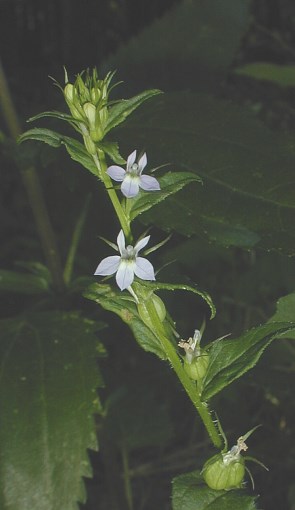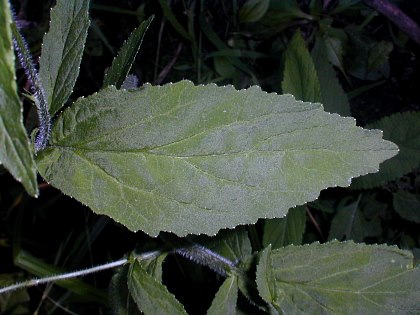Description:
This
plant is a summer annual about ½–2½' tall and more or less
erect. It is unbranched, or branches occasionally in the upper half.
The angular stems have bristly white hairs; these hairs are less
abundant on the upper stems. The alternate leaves are up to 2½" long
and 1" across, becoming smaller as they ascend the stems. They are
lanceolate to ovate in shape and crenate or bluntly dentate along the
margins. The upper surface of each leaf is largely hairless, while the
lower surface has a few hairs along the major veins. The lower leaves
have short petioles, while the upper leaves are sessile. The central
stem terminates in a spike-like raceme of flowers that extends to about
one-half the length of the plant. Some of the upper side stems may
terminate in shorter racemes. Each raceme has alternate leafy bracts
that are similar in appearance to the leaves below, except that they
are smaller. A single flower develops from the base of each bract on a
short petiole; usually a few flowers are in bloom at the same time.
Each flower is up to 1/3" (8 mm.) long; it consists of a tubular
corolla with 5
spreading lobes and a short tubular calyx with 5 teeth that are long
and spreading. The corolla is light blue-violet, light purple, or
white. It has a cleft upper lip consisting of 2 small lobes and a cleft
lower lip consisting of 3 lobes that are somewhat larger. The interior
of the corolla is primarily white; its lower interior has 2 small
yellow patches and tufts of fine white hair. The blooming period occurs
from mid-summer through the fall and lasts about 2-3 months. There is
no noticeable floral scent. After the corolla withers away, a globoid
seed capsule develops that is about 1/3" (8 mm.) across. This capsule
is
completely enclosed by the persistent green calyx. There are several
conspicuous ribs along the sides of this calyx. The seed capsule is
divided into 2 cells and contains numerous tiny seeds; these seeds are
small enough to be blown about by the wind. The root system consists of
a taproot.
ascend the stems. They are
lanceolate to ovate in shape and crenate or bluntly dentate along the
margins. The upper surface of each leaf is largely hairless, while the
lower surface has a few hairs along the major veins. The lower leaves
have short petioles, while the upper leaves are sessile. The central
stem terminates in a spike-like raceme of flowers that extends to about
one-half the length of the plant. Some of the upper side stems may
terminate in shorter racemes. Each raceme has alternate leafy bracts
that are similar in appearance to the leaves below, except that they
are smaller. A single flower develops from the base of each bract on a
short petiole; usually a few flowers are in bloom at the same time.
Each flower is up to 1/3" (8 mm.) long; it consists of a tubular
corolla with 5
spreading lobes and a short tubular calyx with 5 teeth that are long
and spreading. The corolla is light blue-violet, light purple, or
white. It has a cleft upper lip consisting of 2 small lobes and a cleft
lower lip consisting of 3 lobes that are somewhat larger. The interior
of the corolla is primarily white; its lower interior has 2 small
yellow patches and tufts of fine white hair. The blooming period occurs
from mid-summer through the fall and lasts about 2-3 months. There is
no noticeable floral scent. After the corolla withers away, a globoid
seed capsule develops that is about 1/3" (8 mm.) across. This capsule
is
completely enclosed by the persistent green calyx. There are several
conspicuous ribs along the sides of this calyx. The seed capsule is
divided into 2 cells and contains numerous tiny seeds; these seeds are
small enough to be blown about by the wind. The root system consists of
a taproot.
Cultivation:
The preference is partial sun, moist to dry conditions, and a soil that
contains loam, clay loam, or rocky material. Poor soil is readily
tolerated, although this will stunt the growth of the plants somewhat.
Range & Habitat:
The native Indian Tobacco is a fairly common plant that occurs in most
areas of
Illinois; it is less common or absent in a few areas of northern
Illinois (see Distribution
Map). Habitats include open deciduous woodlands, savannas,
thickets, areas along woodland paths, powerline clearances in wooded
areas, partially shaded seeps, and abandoned fields. This species
prefers areas with a history of disturbance, particularly when this
removes some of the overhead canopy in wooded areas. It is somewhat
weedy.
Faunal
Associations: The nectar of the flowers attracts
small bees, mainly Halictid bees. The acrid foliage is highly toxic and
avoided by mammalian herbivores, including White-Tailed Deer. The tiny
seeds appear to be of little interest to birds.

Photographic
Location:
A powerline clearance in Busey Woods at Urbana, Illinois.
Comments:
Notwithstanding the common name, the foliage of Indian Tobacco should
be neither chewed nor smoked as it is highly acrid and toxic. While
Indian Tobacco is an annual, other Lobelia spp.
(Lobelias) in Illinois are perennials with larger flowers. Indian
Tobacco resembles Lobelia spicata (Pale-Spiked
Lobelia), but the latter has slightly larger flowers (up to ½" long)
and its stems have shorter hairs or they are glabrous. Another species,
Lobelia kalmii (Kalm's Lobelia), occurs in various
wetlands and is uncommon in Illinois. It has larger flowers, more
narrow leaves, and lacks spreading hairs on its stems. Indian Tobacco
is distinctive because its calyxes become conspicuously inflated from
the developing seed capsules; this makes it relatively easy to
identify. The calyxes of other Lobelias don't inflate after the
corollas of their flowers have withered away.